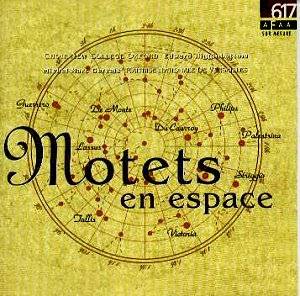K617 are making something of a speciality of cultural
cross-pollination. I recently listened to some Gregorian chant sung
by choir members drawn from Estonia, France and Luxembourg and the stylistic
disparities and confluences added to the creative frisson of the disc.
Now here is another example in which Edward Higginbotham and his French
counterpart, Michel-Marc Gervais, direct a choir drawn from New College
Oxford and La Maitrise Nationale de Versailles, a famous but long inactive
choir that Higginbotham has also helped revive. Together they perform
polyphonic music of the sixteenth century, much of it amongst the greatest
music of the age. In his apologia pro musica sua Higginbotham
notes that the forty voice motets (of, here, Striggio and Tallis) require
larger forces than can be met by one choir but he also concedes that
the affinities and distinctiveness of the two schools, the English and
the French, could be elided and juxtaposed to musical advantage. He
cites the clarity of the English voices and the fullness of the deeper
notes of French singers. In that sense his Pan-Europeanism is analogous
to that other disc’s Pax Christiana – a symbiosis to mutually beneficial
effect.
Most palpable is the sense of tonal depth and flexibility
of the choir. Comparison with, say, the Tallis Scholars’ performance
of Spem in alium reveals something of an aesthetic gulf between
them. The Tallis Scholars performance is of almost remorseless clarity,
each line and strand delineated with tremendous precision whereas Higginbotham
here encourages and receives a more blended, tonally rich sound – not
luxuriant but expressively plangent. My own preference is for a fuller
and richer sound but admirers of the more austere approach will doubtless
point to the potential for polyphonic congestion, which is seldom a
concern to the Tallis Scholars, but which does occasionally visit this
disc. It’s especially instructive, though, to hear the Tallis prefaced
by Striggio’s forty-part Ecce beatem lucem, putatively the work
that provoked Tallis’ own effort. The distance between them is that
between competence and greatness. Admirable too is the roll call of
sixteenth century polyphonists and the singing of, especially, Lassus’
Salve regina and Palestrina’s inexhaustible Stabat mater.
The sound is generously enveloping without clouding the strands
of the lines but something has gone wrong with the booklet notes. Whereas
the musical Entente Cordiale may be flourishing the notes are a return
to the bad old days. The composer profiles seem to have been subjected
to a Yahoo translation service – watch out.
Jonathan Woolf

